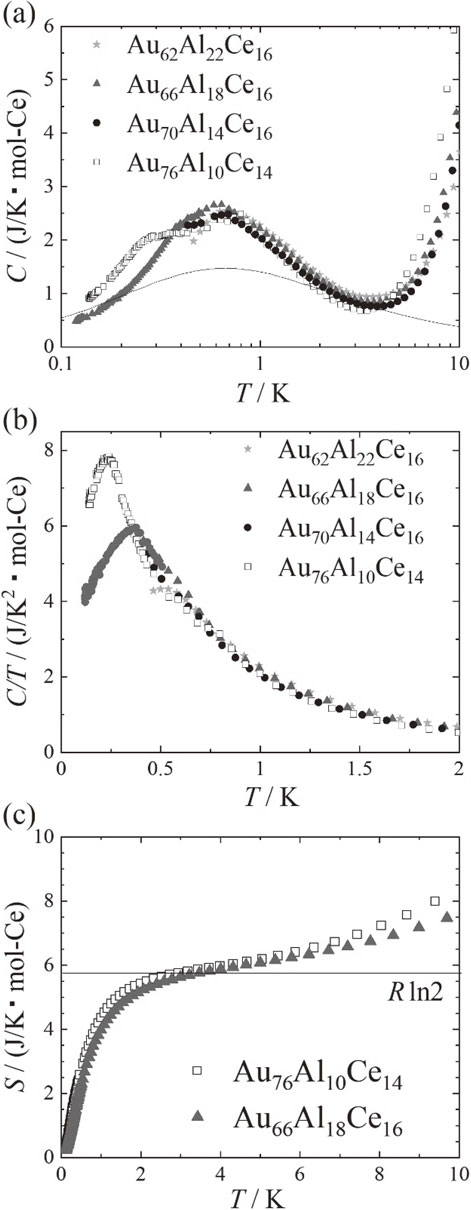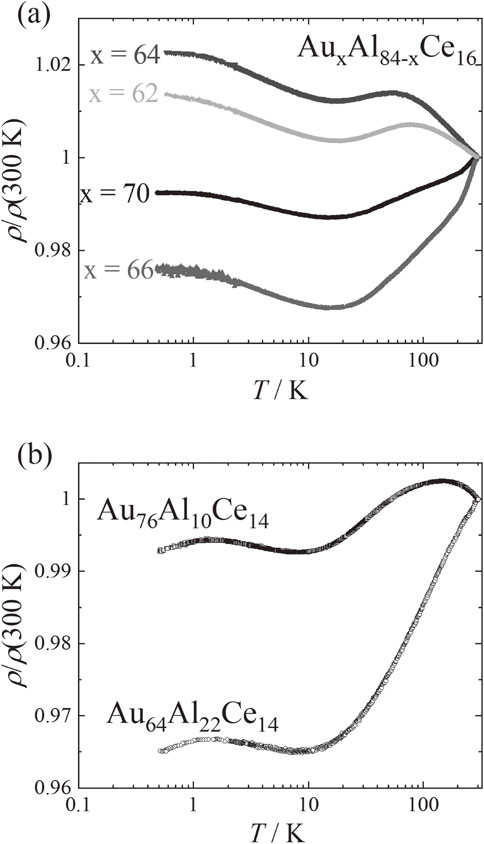2021 Volume 62 Issue 3 Pages 321-324
2021 Volume 62 Issue 3 Pages 321-324
We have studied the magnetic and transport properties of Tsai-type quasicrystalline approximants, AuxAl84−xCe16 and AuyAl86−yCe14 by the measurements of magnetic susceptibility χ, specific heat Cp and electrical resistivity ρ. A Curie-Weiss behavior in χ for all compounds indicates the stable trivalent state of Ce ions in Au–Al–Ce. The effective magnetic moment increases with increasing the Au concentration whereas the Weiss temperature decreases. These behaviors suggest the Kondo effect in Au–Al–Ce suppresses with the increase of Au concentration. In Cp, all measured compounds show a broad peak due to the Kondo resonance at 0.8 K. In addition, Cp/T shows a peak below 0.6 K, which implies the existence of spin-glass transition. In all compounds, a pronounced −log T behavior due to Kondo effect are observed in ρ(T) below 10 K. Moreover, AuyAl86−yCe14 approximants are the first example displaying a precursor of coherent Kondo state at low temperatures because a broad maximum is observed in ρ(T) at 1.3 K.

Fig. 4 Electrical resistivity of (a) AuxAl84−xCe16 and (b) AuyAl86−yCe14.
Since the discovery of stable icosahedral quasicrystal (QC) and its approximants (AC) in binary Cd–R (R = rare earth elements) system,1) magnetic and physical properties of rare-earth based Tsai-type QC’s and AC’s have been studied intensively.2) In Cd6R 1/1 AC, the first report of long-range antiferromagnetic order in AC was done for R = Tb,3) then antiferromagnetic state has been observed at low temperatures in R = Pr, Nd, Sm, Gd, Dy, Ho, Er and Tm.4) The long-range antiferromagnetic transition has been also discovered in ternary Au–Al–R with R = Gd and Tb.5) Especially for R = Tb, a study of neutron diffraction reveals a complex and rotational spin arrangement that should be originated by the geometrical frustration inherent in the icosahedral spin cluster.6) A similar complex spin order is also reported for a canted ferromagnetic order of Au–Si–Tb AC.7)
In some Ce- and Yb-based compounds, on the other hand, characteristic magnetic behaviors such as Kondo effect, heavy fermion and valence fluctuation have been observed in addition to magnetic order.8,9) Because the formation of heavy-fermion state results from strong correlation between 4f electrons and conduction electrons located near the Fermi energy, physics of strongly correlated electrons on the quasiperiodic structure where the Fermi energy is difficult to define has attracted some attention. In fact, a quantum critical behavior that is one of characteristic phenomena in the strongly correlated electron system was discovered in Au–Al–Yb QC.10,11) Although a quantum critical behavior is manifested in Au–Al–Yb AC under hydrostatic pressure,12) the quantum criticality of quasicrystalline phase shows a pronounced difference with that for approximants and other Ce and Yb compounds13,14) in terms of robustness of critical state against pressure. In accordance with the observations of various magnetic features in Au–Al–R system, some unconventional magnetic properties should be expected to observed in other rare earth systems. In this paper, focusing on R = Ce which is vigorously studied in the heavy fermions, we report the magnetic and transport properties of Au–Al–Ce AC by the results of magnetic susceptibility, specific heat and electrical resistivity measurements. In Au–Al–Ce AC, cubic 1/1 and 2/1 approximants exist as observed in Au–Ga–Eu,15) although no QC phases have been discovered yet. We used samples of AuxAl84−xCe16 and Au64Al22Ce14 for 2/1 approximants and Au76Al10Ce14 for 1/1 ones in this study. Especially, for the first time in QC and AC, we observed a resistivity anomaly indicating a precursor for coherent Kondo state in AuyAl86−yCe14 approximants.
Polycrystalline samples of AuxAl84−xCe16 (x = 62, 64, 66, 70) and AuyAl86−yCe14 (y = 64 and 76) were prepared by arc-melting the constituent amount of pure Au, Al, Ce elements. The obtained ingots were then annealed at 1073 K for 50 h. Powder x-ray diffraction patterns of Au–Al–Ce are shown in Fig. 1(a). Bragg peaks at 40° < 2θ < 46° indicate that all AuxAl84−xCe16 and Au64Al22Ce14 crystallize in Tsai-type 2/1 cubic approximant and Au76Al10Ce14 shows the 1/1 approximant. In AuxAl84−xCe16, peaks of Au51Ce14 impurity phase are observed as indicated by cross marks in Fig. 1. On the other hand, no additional peaks due to a secondary phase are observed in AuyAl86−yCe14. The estimated values of lattice parameters a for Au–Al–Ce are summarized in Table 1. Dependence of a on the concentration of Au for AuxAl84−xCe16 is shown in Fig. 1(b). At Fig. 1(b), the relation a2/1/a1/1 ∼ τ, where τ is the golden ratio, is used for the comparison between Au76Al10Ce14 and other 2/1 approximants.16) Figure 1(b) reveals that the unit cell volume of AuxAl84−xCe16 increases with increasing Au, which tendency agrees with that observed in Au–Al–Gd 1/1 approximants.17)

(a) Powder x-ray diffraction patterns for Au–Al–Ce AC. Calculated patterns for Tsai-type 1/1 and 2/1 approximants are also shown. The cross marks represent the Bragg peaks of Au51Ce14 impurity. (b) Au concentration dependence of the lattice parameters for Au–Al–Ce AC. The value for Au76Al10Ce14 1/1 approximant is multiplied by the golden ratio τ.

The magnetic susceptibility χ(T) was measured by using a commercial SQUID magnetometer (Quantum Design MPMS) in the temperature range from 300 K down to 2 K under the magnetic field μ0H = 1 T. The measurements of electrical resistivity ρ(T) were performed by conventional four terminal method using a home-build 3He refrigerator. The specific heat C(T) was measured on a Quantum Design PPMS with He3 option in the temperature range from 20 K down to 0.5 K. In addition, the ADR option for PPMS was used for the ρ(T) and C(T) measurements down to 0.1 K.
Figure 2(a) and (b) show the temperature dependence of inverse magnetic susceptibility χ−1 for AuxAl84−xCe16 and AuyAl86−yCe14, respectively. Linear temperature dependencies of χ−1 below 300 K indicate that all systems obey the Curie-Weiss law. The effective magnetic moment μeff and paramagnetic Curie temperature θp obtained by the least-square fitting above 50 K are summarized in Table 1. The obtained values of μeff are in the range from 2.4 μB to 2.5 μB, which are comparable to the free ion value of Ce3+ (2.54 μB). This result indicates the stable trivalency of Ce ions in Au–Al–Ce AC. As shown in Fig. 2(c), μeff increases with increasing the concentration of Au while θp decreases in AuxAl84−xCe16, indicating that the Kondo effect in AuxAl84−xCe16 suppresses with increasing the concentration of Au. This feature is consistent with the increase of unit-cell volume with increasing Au for Au–Al–R16) because the strength of Kondo effect in most Ce compounds is suppressed by the volume expansion.13) The μeff for AuyAl86−yCe14 shows the same tendency as observed in AuxAl84−xCe16, but the values of θp for AuyAl86−yCe14 are nearly constant and smaller than the half of those for AuxAl84−xCe16. The suppressed θp’s for AuyAl86−yCe14 suggest that the Ce 4f electrons in AuyAl86−yCe14 is more localized than those in AuxAl84−xCe16 because of larger unit-cell volume as shown in Fig. 2(b).

Inverse magnetic susceptibility of (a) AuxAl84−xCe16 and (b) AuyAl86−yCe14. Variations of effective magnetic moment μeff and paramagnetic Curie temperature θp with respect to Au concentration are shown in (c).
Figure 3(a) shows the specific heat C(T) for Au–Al–Ce AC’s below 10 K. All compounds show a maximum at 0.6 K. In Au66Al18Ce16 and Au76Al10Ce14, moreover, a shoulder-like anomaly is observed at 0.4 K and 0.25 K, respectively. These low-temperature anomalies in Au66Al18Ce16 and Au76Al10Ce14 are clearly visualized as a peak in C/T shown in Fig. 3(b). In addition, a peaking behavior is also seen at 0.5 K in C/T for Au66Al18Ce16. A similar peak in C/T is observed in other Ce-based AC Ag–In–Ce.18,19) These reports argue that the origin of C/T peak at 0.4 K in Ag–In–Ce is a spin-glass transition because a sharp cusp is observed in ac-susceptibility at the freezing temperature Tf = 0.3 K. Therefore, peaks in C/T for several Au–Al–Ce should also result from a spin-glass freezing.

Temperature dependence of (a) specific heat C, (b) C/T, and (c) entropy for Au–Al–Ce AC. A solid line in (a) represents the estimated contribution of Kondo resonance, and a horizontal line in (c) indicates R ln 2.
On the other hand, the broad peak in C(T) for Au–Al–Ce should be originated by Ce 4f electrons because, as shown in Fig. 3(c), the entropy derived from the integration of C/T reaches R ln 2 at 4 K at which a minimum shows in C(T). As mentioned in the next section, resistivity for all Au–Al–Ce compounds shows a logarithmic increase due to Kondo effect. Thus we suggest that the peak at 0.6 K in C(T) is that predicted by the impurity Kondo model.9) By using the calculated C for S = 1/2 Coqblin-Schrieffer model,20) the temperature at the peak is reproduced when the Kondo temperature TK is estimated as 1 K as shown by a solid line in Fig. 3(a). However, the measured maximum value of the peak is twice as large as the calculated one. This discrepancy may be caused from the absence of the contributions of spin-glass transition and/or the crystal field effect of the Ce 4f electrons.
3.3 Electrical resistivityFigure 4(a) and (b) show the results of electrical resistivity reduced by the value at 300 K, ρ/ρ(300), for AuxAl84−xCe16 and AuyAl86−yCe14, respectively. At around 100 K, all compounds show a broad peak or shoulder-like anomaly. Then, on cooling below 10 K at which ρ(T) shows a minimum, a −log T behavior is observed. These two features are observed typically in Ce-based Kondo compounds. Therefore, Au–Al–Ce AC systems are categorized as dense Kondo systems.

Electrical resistivity of (a) AuxAl84−xCe16 and (b) AuyAl86−yCe14.
For AuxAl84−xCe16, ρ(T) shows a saturating behavior below 1 K that is conventional feature for the impurity Kondo systems, despite Au–Al–Ce AC possesses the periodicity. On the other hand, ρ(T)’s for both Au76Al10Ce14 and Au64Al22Ce14 display a pronounced maximum at 1.3 K. This behavior is the precursor to the coherent Kondo state that is characteristic for the heavy fermion systems9) thereby AuyAl86−yCe14 approximants should be the first example of coherent Kondo AC. Since the samples of AuyAl86−yCe14 are nearly single phase whereas those of AuxAl84−xCe16 contain small amount of Au51Ce14 impurity phase, the low-temperature coherent state in Au–Al–Ce AC should be sensitive to the sample quality. Thus it should be worth studying the magnetic property of Au–Al–Ce AC by using single crystals.
In summary, we performed measurements of magnetic susceptibility, specific heat and electrical resistivity for a series of Au–Al–Ce quasicrystalline approximants, AuxAl84−xCe16 and AuyAl86−yCe14. Curie-Weiss behavior in the magnetic susceptibility indicates the stable trivalency of Ce ions in all Au–Al–Ce approximants. The effect of composition on the effective magnetic moment and paramagnetic Curie temperature reveals that the strength of Kondo effect decreases with increasing the concentration of gold. Low-temperature specific heat displays anomalies possibly due to the Kondo effect and spin-glass freezing. The electrical resistivity of all Au–Al–Ce approximants shows a −log T behavior characteristic for Ce Kondo compounds below 10 K. Furthermore, we first observed a resistivity maximum at 1.3 K that is a precursor of coherent Kondo state in AuyAl86−yCe14 approximants.
The authors thank S. Suzuki for fruitful discussion. This work was supported by JSPS KAKENHI Grant Number JP19H05818.